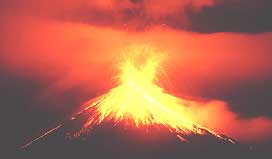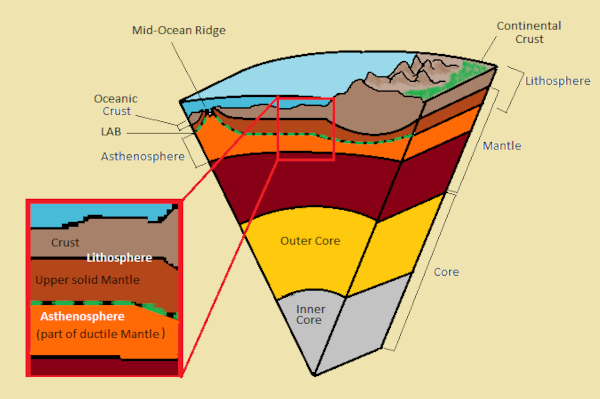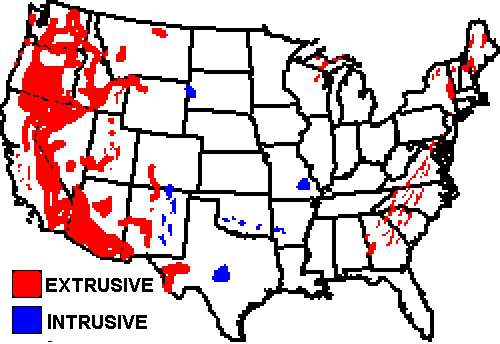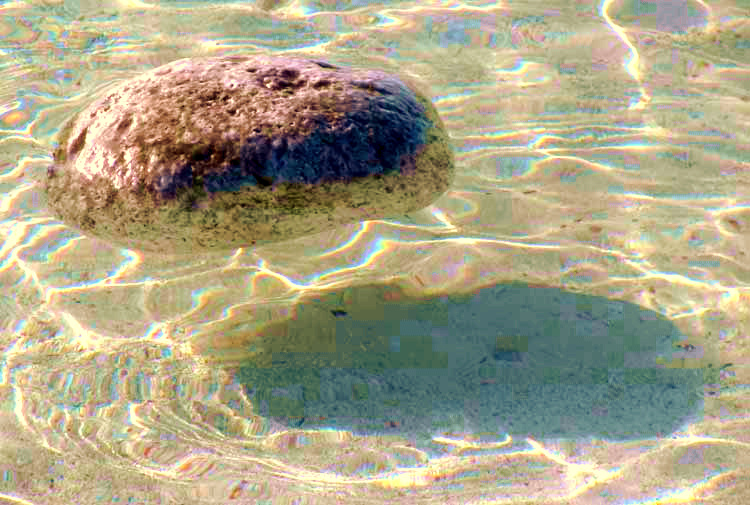
 The molten rock erupting from the volcano at the left is lava. When the volcano stops erupting, there will still be plenty of molten rock inside and below the volcano, and that "un-erupted lava" is known as magma. When lava and magma cool, they solidify into igneous rock.
The molten rock erupting from the volcano at the left is lava. When the volcano stops erupting, there will still be plenty of molten rock inside and below the volcano, and that "un-erupted lava" is known as magma. When lava and magma cool, they solidify into igneous rock.
Both lava and magma can be composed of very different mixtures of minerals.The nature of igneous rocks very much depends on which minerals the lava or magma were made of, and how quickly the lava or magma cools off.
Magma originates in the lower part of the Earth's crust and the upper portion of the mantle, which the diagram below reminds us is relatively near the surface.

The Earth's core and the much greater part of the mantle are not magma. Igneous-rock-forming magma constitutes a relatively small part of the Earth's interior.
INTRUSIVE AND EXTRUSIVE IGNEOUS ROCKS

Most of the Earth's magma never reaches the surface and never becomes lava. Eventually magma remaining inside the Earth hardens into intrusive igneous rock, often called plutonic rock. The map at the right shows that, in the US -- despite most igneous rock being intrusive -- at the surface we're more likely to see extrusive igneous rock.

A big difference between intrusive and extrusive igneous rock is that the magma from which intrusive rock derives may have taken thousands or millions of years to cool enough to form rock. During that time, crystals form. The longer the time taken to cool, the larger the crystals. The most abundant intrusive igneous rock is granite. At the left, a close-up of a granite surface shows large, solid white areas. Those are grown-together crystals of quartz and orthoclase feldspar, with the dark spots being various dark minerals.

In contrast, magma erupted onto the Earth's surface immediately begins cooling at a relatively fast rate. The resulting extrusive rock may have cooled so fast -- by falling into water, for example -- that it forms no crystals at all, and forms rocks the texture of shattered glass, such as obsidian. Or the erupting magma may contain so much pressurized gas that the exploded, depressurized magma may form extrusive rock so full of holes and bubbles that it floats on water, as seen at the right.
SPECIAL WORDS FOR IGNEOUS ROCKS
FELSIC: Containing mostly light-colored minerals such as quartz, feldspars, or muscovite
MAFIC: Containing mostly dark-colored, magnesium- or iron-rich minerals such as biotite, pyroxene, or olivine
APHANITIC: Fine-grained igneous rock in which different minerals can't be seen without magnification
GLASSY or VITREOUS: Rock texture similar to broken glass and developed as a result of rapid cooling of the lava without distinctive crystallization.
PHANERITIC: Rock texture in which mineral grains are large enough to be seen with the unaided eye and are of approximately equal size
PROPHYRITIC: Rock of any composition containing conspicuous larger crystals (phenocrysts) surrounded by fine-grained rock.